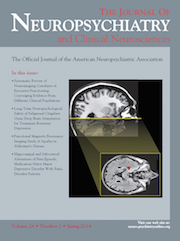To the Editor: A 57-year-old woman with past medical history of paranoid schizophrenia (diagnosed during college), hypertension, and diabetes suffered multiple embolic cerebral vascular accidents (CVAs) resulting in right-sided hemiplegia with neglect, was admitted to the long-term care nursing facility for rehabilitation. The patient's vitals and complete blood count were within normal limits. She was fed via a gastrostomy tube. Within a week of her admission, patient started having episodes of restlessness and crying and wailing out loud. The episodes would start within seconds and last for 5 to 15 minutes nearly every hour throughout, without any clear precipitants; she had tears and was inconsolable. For the initial 2 months, she was given lorazepam and fluoxetine to control these episodes without any success. Fluoxetine was later replaced with valproate 750 mg at bedtime for irritability, mood lability, and crying spells, with slight though insufficient improvement. Because of her expressive and receptive aphasia, evaluation for any evidence of delusions or hallucinations was difficult. She was not noted to be responding to any internal stimuli and antipsychotics were not deemed necessary.
After nearly 6 months of involuntary crying episodes, a diagnosis of pseudobulbar affect was considered. Patient was started on dextromethorphan/quinidine (Nuedexta) 20 mg/10 mg b.i.d. The patient's involuntary crying episodes reduced considerably in frequency and duration within the first 2 months of the start of dextromethorphan/quinidine. Patient did not experience any side effects of dextromethorphan: nausea, vomiting, dizziness, and stomach pain while on the medication. Valproate was discontinued over time. After about 6 months of treatment, dextromethorphan/quinidine was discontinued as patient’s symptoms were significantly reduced. In less than 1 week, the patient’s crying episodes resumed. Thereafter, dextromethorphan/quinidine was restarted. After one and a half years on dextromethorphan/quinidine, her crying episodes were reduced in duration some lasting only a few minutes with much reduced frequency (<3–4 episodes per day) or sometimes none over a period of 6–7 hours. The patient is currently doing well with stable vitals and complete blood count. She is showing good improvement in her communication with caretakers for her needs.
Discussion
Pseudobulbar affect (PBA) is characterized by uncontrollable outbursts of laughter and/or crying episodes that lack an appropriate environmental trigger; is either unrelated or out of proportion to the emotions felt by the patient; and is secondary to a neurological disease or injury. PBA is also known as emotional lability, pathological laughing and crying, or intermittent explosive emotional dysregulation and can occur in patients with amyotrophic lateral sclerosis (ALS) and stroke, as well as in diverse neurological conditions such as multiple sclerosis, traumatic brain injury, Alzheimer’s disease, and Parkinson’s disease.
1 Dextromethorphan/quinidine 20 mg/10 mg (Nuedexta) twice daily is indicated in the US for the treatment of PBA.
Dextromethorphan, the active agent, is a potent presynaptic sigma−1 receptor agonist and postsynaptic noncompetitive N-methyl-D-aspartate (NMDA) receptor antagonist, and inhibits glutamatergic signaling in brain regions with high sigma−1 receptor expression, primarily the brainstem and cerebellum. Thus, dextromethorphan acts in brain regions believed to be associated with emotion expression disorders, without causing unwanted systemic effects. Quinidine inhibits CYP2D6 liver enzyme metabolism of dextromethorphan, to increase dextromethorphan plasma concentrations.
1Studies have found PBA to be a frequently reported post-stroke behavioral symptom, with a prevalence rate ranging from 11% to 52%, particularly in older patients with a history of prior stroke and subcortical strokes involving internal capsules and neighboring basal ganglia.
2There are case reports of patients with PBA successfully treated with antidepressants.
3,4 Lamotrigine has also been reported to be helpful.
5 This case report illustrates that dextromethorphan/quinidine was well tolerated in a patient with schizophrenia, that it was more effective than antidepressant and mood stabilizer, that withdrawal of the medication led to return of symptoms, and that long-term treatment may be needed to keep symptoms under control.

